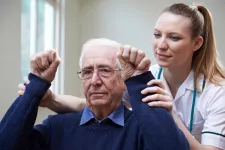Small 'window of opportunity' for best recovery after stroke
2021-02-16
(Press-News.org) An international study has shown, for the first time, that the capacity of the human brain to recover and rewire itself peaks around two weeks after a stroke and diminishes over time.
The finding, published today in the Neurorehabilitation and Neural Repair journal, is the result of a study in London and Adelaide that followed the recovery of 60 stroke patients up to one year after their stroke.
Lead author Dr Brenton Hordacre, from the University of South Australia, says the multi-site study showed conclusive evidence that the brain only has a small window of opportunity to more easily repair itself after stroke.
"Earlier animal studies suggested this was the case, but this is the first time we have conclusively demonstrated this phenomenon exists in humans," Dr Hordacre says.
The researchers scanned the brains of stroke survivors as they recovered over 12 months. They found that in the initial days following an ischemic stroke (caused by a blocked artery to the brain), the brain has a greater capacity to modify its neural connections and its plasticity is increased.
"It is during this early period after stroke that any physiotherapy is going to be most effective because the brain is more responsive to treatment.
"Earlier experiments with rats showed that within five days of an ischemic stroke they were able to repair damaged limbs and neural connections more easily than if therapy was delayed until 30 days post stroke."
The researchers used continuous transcranial magnetic stimulation (cTBS) to repetitively activate different hemispheres of the motor cortex to measure brain plasticity.
The Adelaide laboratory tested the stroke damaged motor cortex, which is the main area that controls movement. The London laboratory tested the non-stroke damaged hemisphere which is also important to help recovery.
"Our assessments showed that plasticity was strongest around two weeks after stroke in the non-damaged motor cortex. Contrary to what we expected, there was no change in the damaged hemisphere in response to cTBS."
Dr Hordacre says the findings confirm the importance of initiating therapy as soon as possible after a stroke.
Current evidence indicates that less than eight minutes of daily therapy is dedicated to upper limb recovery within the first four weeks of a stroke.
"Delivering more treatment within this brief window is needed to help people recover after stroke.
"The next step is to identify techniques which prolong or even re-open a period of increased brain plasticity, so we can maximise recovery," Dr Hordacre says.
INFORMATION:
Notes to Editors
The paper, "Evidence for a Window of Enhanced Plasticity in the Human Motor Cortex following Ischemic Stroke" is available at: https://journals.sagepub.com/doi/full/10.1177/1545968321992330
Researchers from the following institutions were involved in the study: University of South Australia; University College London (UCL); University of Adelaide; Hospital Universitario Ramón y Cajal and Hospital Ruber Internacional in Madrid; Queen Mary University, London; the Royal London Hospital; National Hospital for Neurology and Neurosurgery, London; Murdoch University, WA; Royal Adelaide Hospital; and the Physio Clinic, Adelaide.
[Attachments] See images for this press release:

ELSE PRESS RELEASES FROM THIS DATE:
2021-02-16
Icebergs are melting faster than current models describe, according to a new study by mathematicians at the University of Sydney. The researchers have proposed a new model to more accurately represent the melt speed of icebergs into oceans.
Their results, published in Physical Review Fluids, have implications for oceanographers and climate scientists.
Lead author and PhD student Eric Hester said: "While icebergs are only one part of the global climate system, our improved model provides us with a dial that we can tune to better capture the reality of Earth's changing climate."
Current models, which are incorporated into the methodology used by the Intergovernmental Panel on Climate Change, ...
2021-02-16
Over the past years, global data traffic has experienced a boom, with over 12.5 billion connected devices all over the world. The current world-wide deployment of the 5G telecommunications standard is triggering the need for smaller devices with enhanced performances, such as higher speed, lower power consumption and reduced cost as well as easier manufacturability.
In search for the appropriate technology, photonic devices emerged as the leading technology for the evolution of such information and communication technologies, already surpassing ...
2021-02-16
ADELPHI, Md. -- The Army of the future will involve humans and autonomous machines working together to accomplish the mission. According to Army researchers, this vision will only succeed if artificial intelligence is perceived to be ethical.
Researchers, based at the U.S. Army Combat Capabilities Development Command, now known as DEVCOM, Army Research Laboratory, Northeastern University and the University of Southern California, expanded existing research to cover moral dilemmas and decision making that has not been pursued elsewhere.
This research, featured in Frontiers in Robotics and AI, tackles the fundamental challenge of developing ethical artificial intelligence, ...
2021-02-16
The human condition is riddled with extreme events, which bring chaos into our lives. Natural disasters leave a trail of destruction, causing direct and horrible pain and suffering - costing lives, creating injuries, destroying houses, livelihoods, crops and broken infrastructures. While extensive research has been conducted on the economic and public healthcare costs of these types of disasters around the world, their effect does not end there. A team of researchers from the Hebrew University of Jerusalem sought to better understand the behavioral and social implications ...
2021-02-16
Psychotherapy for panic disorder produces good results, and the effects are lasting. That is the result from a large long-term study from Lund University in Sweden. Two years after treatment were 70 per cent of the patients clearly improved and 45 per cent were remitted.
Panic disorder is one of the most common causes of mental illness in Sweden and worldwide. Approximately 2 per cent have panic disorder. When untreated, the condition is associated with emotional distress and social isolation. Panic attacks often debut in adolescence or early adulthood and many of those affected ...
2021-02-16
We live in modern times, that is full of electronics. Smartphones, laptops, tablets, and many other devices need electrical energy to operate. Portable devices made our lives easier, so novel solutions in clean energy and its storage are desirable. Lithium-ion (Li-ion) batteries are the most common solutions that dominate the global market and are a huge problem due to their insufficient recovery. Because of their limited power, short cycle life, and non-environment-friendly nature, scientists recently focused on novel solutions like supercapacitors that offer much more than batteries. Why? Let's take a look closer at these devices.
Supercapacitors bring together the properties of a standard capacitor and the Li-ion battery. In practice, ...
2021-02-16
Following the civil war outbreak in Syria nearly ten years ago, Israel began admitting wounded Syrians into the country for humanitarian medical treatment.
In accordance with the Israeli government's decision, the Israel Defense Forces, medical corps, health care system and hospitals in the north of the country joined together to provide medical treatment to thousands of wounded Syrians. The logistics of evacuating the injured from the battlefield and transferring them to Israeli territory was often prolonged due to the fact that Israel and Syria are defined as enemy countries.
Most of the wounded were brought to the Galilee ...
2021-02-16
Biophysicists at Ludwig-Maximilians-Universitaet (LMU) in Munch have developed a new theory, which accounts for the observation that cells can perceive their own shapes, and use this information to direct the distribution of proteins inside the cell.
Many cellular processes are critically dependent on the precise distribution and patterning of proteins on the cell membrane. Diverse studies have shown that, in addition to protein-protein interactions and transport processes, cell shape can also have a considerable impact on intracellular pattern formation. Conversely, there are patterning processes in which any dependence on cell form would be deleterious. Using starfish oocytes as a model system, LMU physicists led by Professor Erwin ...
2021-02-16
In shallow water, less than 30 metres, the survival of hard corals depends on photosynthetic unicellular algae (zooxanthellae) living in their tissues. But how does the coral adapt at depth when the light disappears? French researchers from the CNRS, EPHE-PSL and their international collaborators, associated with Under the Pole (Expedition III), have studied for the first time the distribution of these so-called mesophotic corals in the French Polynesian archipelago, from the surface to 120 metres deep (with a record descent of 172 metres). As the amount of light decreases, the coral associates ...
2021-02-16
DARIEN, IL - A new study found that treating obstructive sleep apnea with CPAP therapy increased self-reported physical activity in adults with a history of heart disease.
During a mean follow-up period of 3.7 years, the group treated with CPAP therapy reported approximately 20% higher levels of moderate physical activity compared with the control group. The study also found the CPAP group was more likely to report activity levels consistent with expert recommendations.
"We were pleased to find that our CPAP users reported that they were better able to maintain their levels of activity over the four years of the study, and that they reported fewer limitations in moderate and vigorous activities including those that are important for independent aging, like walking up the stairs," ...
LAST 30 PRESS RELEASES:
[Press-News.org] Small 'window of opportunity' for best recovery after stroke



